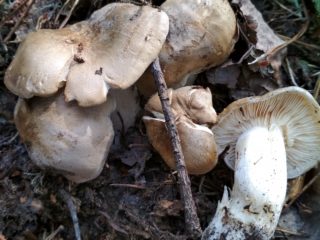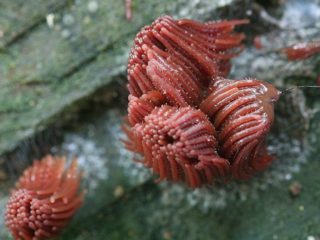Content
Smoky row, smoky-gray lyophyllum, gray or smoky-gray lyophyllum is a conditionally edible species of the Lyophyllaceae family. In mycology it is known by the Latin names Lyophyllum fumosum or Clitocybe fumosa. Fruiting is abundant in autumn. The main distribution area is dry coniferous forests.
What do smoky gray lyophyllums look like?
The representative grows in a dense bunch; due to the method of vegetation, the shape of the mushroom is quite varied. The central specimens often have deformed fruiting bodies. The color is light ash or smoky gray with a brown tint.
The appearance description is as follows:
- The cap of young lyophyllums is convex, cushion-shaped, and grows up to 8 cm in diameter.Ripe mushrooms have a prostrate, flat shape with uneven, wavy, concave edges and rare longitudinal cracks. The shape is asymmetrical, the central part has a rounded depression.
- The surface is dry with small and large bulges and depressions. At the beginning of growth it is covered with small, poorly attached flakes. After precipitation, they crumble, the protective film becomes matte and smooth.
- The bottom layer is formed by thin, well-fixed plates, white in young mushrooms, with a gray tint in mature ones. The arrangement is sparse with a clear boundary near the stem.
- The pulp is dense, thick, mostly white, gray near the protective film. Fruit body with a slight nutty odor and sweet and sour taste.
Smoky gray lyophyllums grow very densely, so the shape of the stem can be straight or curved in any direction. Possible fusion of the lower parts of two adjacent mushrooms. In specimens free from compression, the shape is cylindrical, tapering upward. Those located in the middle are fused and flat. The surface has a light white coating, the structure is hollow, coarse-fibered with longitudinal stripes, length – 10-12 cm, quite thick. Color - from beige to dark gray. In one group, the color of mushrooms may differ.
Where do smoky gray lyophyllums grow?
A frequently encountered species, its range covers:
- Far East;
- Ural;
- Siberia;
- Central regions to the North Caucasus.
Smoky-gray lyophyllums grow everywhere in Russia where coniferous and mixed forests occur. Mycorrhizae form mainly with pine trees, less often with oaks.
The species is located on dry areas, coniferous or moss cushions in the form of numerous clumps. One group can have up to 20 fruiting bodies. Rarely found alone.The fruiting period is long; harvesting begins at the end of July after heavy rainfall. The last mushrooms are found in mild climates at the end of October.
Is it possible to eat smoky gray lyophyllums?
The flesh of adult specimens is somewhat harsh, especially the stem. It has a sour taste, a pleasant, light smell. Smoky-gray lyophyllums do not have high nutritional value in terms of chemical composition and taste. There are no toxic compounds in the fruiting body. The advantage of the species is its abundant compact fruiting, so lyophyllum was included in the conditionally edible fourth group.
False doubles
Outwardly, it is impossible to distinguish smoky-gray lyophyllums from twisted row. Initially, mushrooms were classified as one species, then they were separated.
The fruiting bodies of the double are smaller, the concretions are not so dense and numerous. The species is widespread in broad-leaved forests, forms mycorrhiza with birch, and is located on the leaf litter of dry forest areas. The color of the cap has brown tints and a scaly central part. Species from the same food category.
The fused row is larger in size, creamy, almost white in color.
In terms of nutrition, pulp structure and growth method, the species are the same. The fused row is associated with deciduous forests; it grows in symbiosis with birch, and less often with aspen. There is no acid in the taste, there is practically no smell. According to mushroom pickers, the fruit body is fresh even after processing. Lyophyllum intergrown is classified as a conditionally edible fourth category.
Lyophyllum shimeji grows in coniferous tracts on poor soils and dry areas. Forms a few clusters, the fruiting bodies are larger, the stem is thicker.
The color of the cap is dominated by brown tones. Autumn fruiting.
Collection rules
Smoky-gray lyophyllums are collected in the same places; every year the mycelium grows, the yield becomes higher. Do not take overripe specimens damaged by insects. Mushrooms near wastewater treatment plants, city landfills, highways, and factories are unsuitable for food. Fruiting bodies absorb and accumulate harmful substances from the soil and air. May cause poisoning.
Use
The smoky row is used in cooking only after boiling. Heat treatment makes the product softer and eliminates the sour taste. The smell only intensifies as it cooks. Fruit bodies are fried, stewed with vegetables and meat, and soup is prepared. Used for winter preparation, the product is cut into pieces and frozen. Mushrooms are delicious when salted and pickled. They are rarely used for drying; the workpieces are too hard.
Conclusion
Smoky-gray lyophyllum belongs to the fourth category in terms of nutritional value; it grows in dense, numerous clumps from late summer to mid-autumn. Distributed in temperate and warm climates, in mixed and coniferous forests. More often it is in symbiosis with pine. Settles in open dry areas, moss or pine litter.













